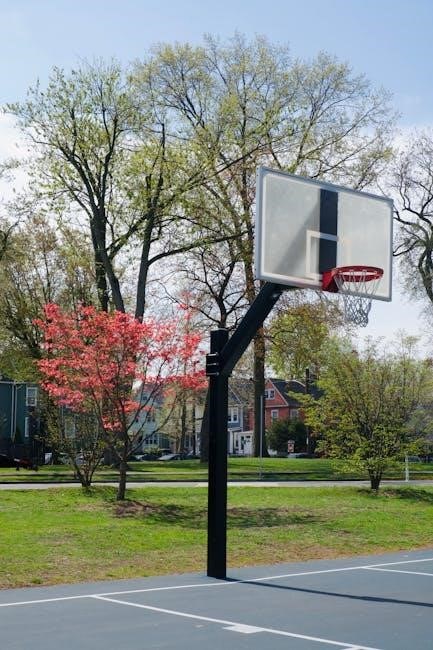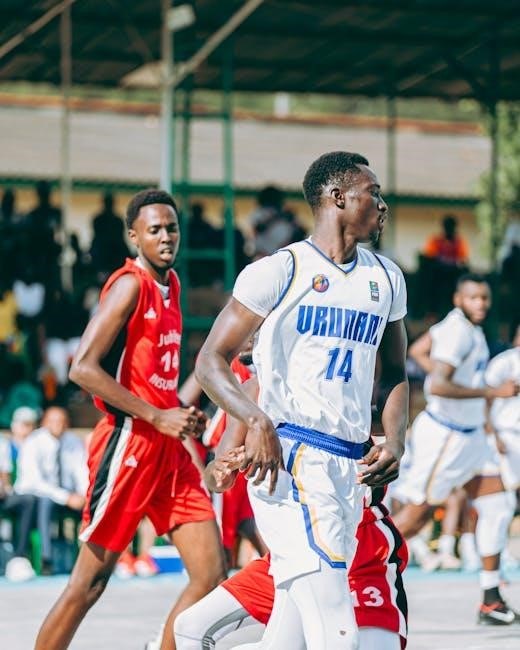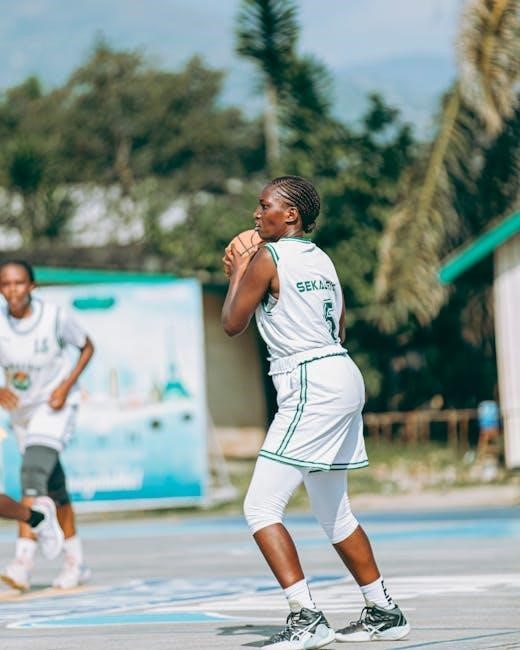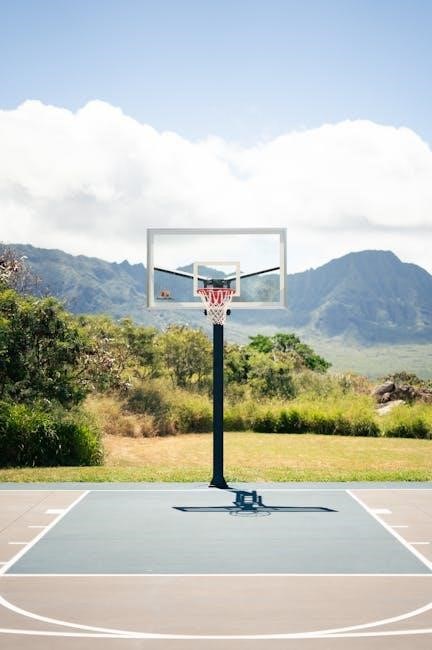Basketball is a dynamic team sport played by two teams of five players each, aiming to score by shooting a ball into the opponent’s hoop. It combines speed, strategy, and skill, making it one of the world’s most popular sports. Originating in 1891, basketball has evolved into a global phenomenon, enjoyed by millions for its excitement and competitive nature.

1.1 Basic Rules and Objective
Basketball’s primary objective is to score more points than the opposing team by shooting the ball into their hoop. Players can move the ball by dribbling or passing. The game is played on a court with a 24-second shot clock for offensive teams. Fouls, such as holding or pushing, result in free throws. Common violations include traveling and double dribbling. The team with the most points at the end of four quarters wins the game.
1.2 History of Basketball
Basketball was invented in 1891 by Dr. James Naismith, a physical education instructor, who created 13 rules for the game. The first game used peach baskets as hoops, and the ball was a soccer ball. The sport quickly gained popularity, and by the 20th century, colleges and professional leagues emerged. The NBA, founded in 1946, became the premier professional league, while the WNBA followed in 1997. Today, basketball is a global sport, enjoyed at both amateur and professional levels worldwide.
1.3 Benefits of Playing Basketball
Basketball is a fantastic way to improve physical and mental health. It enhances cardiovascular fitness, builds muscle strength, and boosts coordination. The sport also fosters teamwork, communication, and discipline. Playing basketball can reduce stress, improve focus, and promote self-confidence. Additionally, it encourages social interaction and camaraderie among players. Regular play can lead to better overall well-being by combining physical activity with mental engagement, making it an excellent choice for people of all ages.

Essential Skills in Basketball
Basketball requires mastery of dribbling, shooting, passing, and defense. These skills are fundamental for players to excel individually and contribute effectively to team success.
2.1 Dribbling Techniques
Dribbling is a fundamental skill in basketball, requiring hand-eye coordination and practice. Players must keep their heads up, stay low, and control the ball with fingertips; stationery dribbles, like the stationary and crossover dribbles, improve ball control. Moving dribbles, such as the speed and behind-the-back dribbles, enhance agility. Mastery of these techniques allows players to navigate the court effectively, evade defenders, and create scoring opportunities. Regular practice with both hands builds versatility and confidence.
2.2 Shooting Fundamentals
Shooting is a critical offensive skill in basketball, requiring precision and technique. Proper stance, with feet shoulder-width apart and dominant foot forward, is essential. Players must grip the ball with fingertips, aligning their shooting shoulder with the hoop. A smooth, consistent motion, extending the elbow and snapping the wrist, ensures accuracy. Squaring the body to the basket and following through on the shot enhances control and balance. Practice from various distances and angles builds proficiency and confidence in scoring.

2.3 Passing Strategies
Effective passing is vital for maintaining possession and creating scoring opportunities. Players should use chest passes for short, accurate deliveries and bounce passes for longer distances. Overhead passes are ideal for bypassing defenders. Vision and decision-making are key; anticipating teammates’ movements ensures precise deliveries. Practicing different passing angles and speeds enhances versatility. A well-executed pass can disrupt defenses and lead to open shots or drives, making it a cornerstone of offensive success in basketball.
2.4 Defensive Tactics
Defensive tactics focus on preventing the opponent from scoring. Man-to-man defense assigns each player to guard an opponent, while zone defense involves protecting specific areas. Help defense provides support when a teammate is beaten. Switching is used to counter screens, and pressing disrupts the opponent’s offense. Anticipating passes and staying in front of the ball are crucial. Effective communication and positioning are key to a strong defense, making it a cornerstone of a team’s success in basketball.
Player Positions and Roles
Basketball features five key positions, each with unique responsibilities. Understanding these roles is essential for building a cohesive team and executing effective strategies during gameplay.

3.1 Point Guard
The point guard is the team’s playmaker, responsible for bringing the ball up the court and setting up offensive plays. They require excellent dribbling, vision, and passing skills to create scoring opportunities for teammates. Point guards often act as the team’s leader, making strategic decisions and controlling the tempo of the game. Their ability to balance scoring and playmaking is crucial for the team’s success. Strong defensive skills are also essential, as they often guard the opponent’s best ball handler.
3.2 Shooting Guard
The shooting guard is a high scorer and reliable shooter, often the team’s primary offensive threat. They excel at scoring from the perimeter and mid-range, with the ability to create shots off the dribble or spotting up. Shooting guards must have strong ball-handling skills to complement their scoring ability and act as secondary playmakers. Defensively, they are expected to guard the opponent’s best scorer, combining offensive and defensive responsibilities to contribute to the team’s overall performance.
3.3 Small Forward
The small forward is a versatile player who excels in scoring, rebounding, and defending. They often serve as a team’s all-around contributor, capable of scoring from the perimeter and driving to the basket. Small forwards are typically agile and athletic, making them key players in fast breaks and defensive matchups. Their ability to handle the ball and create opportunities for teammates makes them invaluable in both offensive and defensive situations, often acting as a bridge between guards and forwards.
3.4 Power Forward
The power forward is a key position requiring strength, versatility, and the ability to score and rebound. They often play near the basket, utilizing physicality to score and defend. Power forwards are expected to secure rebounds, contest shots, and provide a presence in the paint. Their role blends scoring, defense, and physicality, making them vital to controlling the game’s tempo and dominating the boards. They often serve as the team’s enforcer and are crucial in both offensive and defensive schemes.
3.5 Center
The center is typically the tallest player on the team, playing a pivotal role in defending the basket and rebounding. They are responsible for protecting the paint, blocking shots, and securing rebounds on both ends of the court. Offensively, centers often score close to the hoop using post moves or dunks. Their physical presence and ability to alter shots make them a crucial defensive asset. While their role has evolved, they remain key to controlling the boards and defending the rim.

Game Strategies and Tactics
Basketball strategies involve game plans, player positioning, and play execution. Teams use tactics like ball movement, spacing, and timing to outmaneuver opponents. Adaptability during games is crucial.
4.1 Offensive Plays
Offensive plays in basketball are structured strategies to create scoring opportunities. Teams use ball movement, player positioning, and timing to exploit defensive weaknesses. Popular plays include the pick-and-roll, give-and-go, and isolation sets. Spacing and cutting are critical to free up shooters or drivers. Effective offenses balance individual creativity with disciplined execution, ensuring all players contribute. Adapting plays to the defense’s strengths and weaknesses is essential for success. Well-executed offensive plays lead to higher-scoring efficiency and better control of the game’s tempo;

4.2 Defensive Schemes
Defensive schemes in basketball are strategies to limit the opponent’s scoring opportunities. Common schemes include man-to-man, zone, and press defenses. Man-to-man focuses on individual matchups, while zone defense protects specific areas of the court. Press defenses apply pressure to disrupt ball movement. Effective communication, anticipation, and positioning are key to success. Teams often adapt their defensive schemes based on the opponent’s strengths and game situations. Strong defensive schemes can force turnovers, disrupt rhythm, and control the game’s tempo, ultimately leading to victory.

Injury Prevention and Management
Injury prevention in basketball involves proper warm-ups, stretching, and technique. Management includes immediate care, rehabilitation, and recovery strategies to ensure player safety and quick return to play.
5.1 Common Basketball Injuries
Basketball players often suffer from injuries such as ankle sprains, knee injuries (e.g., ACL tears), hamstring strains, and concussions. These injuries occur due to sudden stops, jumps, and collisions. Proper warm-ups and safety measures can reduce their incidence, ensuring player well-being and longevity in the sport.
5.2 Warm-Up and Stretching Routines
A proper warm-up and stretching routine are essential for basketball players to prepare their muscles, improve flexibility, and reduce injury risk. Start with light cardio like jogging or jumping jacks, followed by dynamic stretches such as leg swings, arm circles, and torso twists. Focus on key muscle groups like hamstrings, quadriceps, and calves. Static stretches should be held for 20-30 seconds post-workout to enhance recovery. A well-structured routine ensures optimal performance and longevity in the game.

5.3 Recovery Techniques
Effective recovery techniques are vital for basketball players to restore energy, repair muscles, and maintain peak performance. Key methods include hydration, proper nutrition, and adequate sleep. Foam rolling, ice baths, and compression garments can reduce muscle soreness. Active recovery, such as light jogging or swimming, promotes blood flow without overexertion. Incorporating these practices into a post-game or practice routine helps prevent injuries and enhances overall athletic longevity, ensuring players remain competitive and healthy throughout the season.
